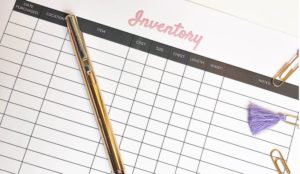DISCLAIMER: As an Amazon associate i earn from qualifying purchases. This post contains affiliate links which will reward me monetarily (or otherwise) when used to make qualifying purchases. for more info, please see my disclosure policy.
Is inventory taking over your office? Maybe you’re poshing from your bedroom, or eBaying from your living room? Perhaps you want to start your own online reselling business or online store, like Etsy, but the lack of knowing how to organize and store inventory is keeping you from starting?
I completely understand.
When I first started selling on Poshmark, I had no inventory system whatsoever, simply because I had no idea where to begin.

Not having an inventory system caused me so much unnecessary stress in my business. After spending forever freaking out trying to find items after they shipped, and having to cancel an order because I couldn’t find an item, I quickly realized I needed an inventory system in place.
Not to mention that time. is. money! Who wants to be spending hours every week searching for inventory when you could be sourcing or selling it instead?
If you’ve had enough of the disorganization taking over your space, or want to change what you’re constantly doing, you’re in luck!
Today we’re discussing various inventory management systems, so you can be a little less stressed… and a lot more organized!
Inventory Management Methods
While there are many ways to organize your inventory for Poshmark or eBay, here are a few common ways:
1. Enter inventory #'s into titles
This is a fairly straightforward method, and what I use (which I explain here).
Once your item has been assigned an inventory letter or number, simply add it to the end of your listing title.
When your listing sells, the identifier will show up in your email since it’s part of the title. This makes it incredibly easy to find and pull inventory quickly because there are no extra steps needed to see where the item is located.
Sidenote: Titles are valuable space for descriptors/SEO, so be conscious that using this method will take up character space. If you’re worried about this, the SKU method below may be a better fit!
2. Utilize SKUs
Also known as stock keeping unit, this is a number that identifies a particular product. While these are commonly thought of as being used by big retailers, they’re also a great tool for sellers like you and me!
Adding a SKU is fairly similar to the method above, except that the inventory number is an actual field filled out when listing.


So, instead of just adding a number in the title or description, you’re adding the inventory letter or number into a specific field.
When listing on Poshmark, you will find the SKU in the additional details section toward the bottom of your listing. The SKU is private, so can only be viewed by you!
On eBay, you’ll see the custom label field (aka a SKU) number towards the top of your listing. When an item sells, the SKU should show up in the details of your seller dashboard.
This method is perfect if you like having your inventory number with the rest of your listing details, but don’t want to have it take up valuable character space!
3. Create A Spreadsheet
Spreadsheets are a great tool if you prefer to have all of your inventory details in one central location.
You can easily create your own using Excel or Google Docs, or utilize free downloadable copies online. I started out using a free spreadsheet from Healthy Girl Fashion to organize my inventory, and now use it to log my solds.
Spreadsheets are useful because you can incorporate as much or as little information as you want. If you only want to have the item name followed by the inventory number, you can do that!

You can also have incredibly detailed spreadsheets, too.
There are lots of downloadable options for resellers available online for purchase, such as the Reselling for Profit Tracking workbook, shown above.
This has a spot for your item number, along with tons of other useful information, such as expense tracking, monthly breakdowns of sales metrics, consignment information, and a sales tracker.
Plus, it’s made by a fellow reseller and can be used for a variety of platforms. Gotta love resellers supporting resellers!
4. Write in a notebook
If you enjoy having things down on pen and paper (I totally feel you), logging your inventory in a notebook may be the way to go.
You can have a dedicated inventory notebook (literally any notebook will do), where you write the name of the item, and next to it, the inventory letter or number.
There are also notebooks dedicated towards resellers (cool, right?!), like this one on Amazon.
5. Printable Spreadsheets
If you want to combine the look of a spreadsheet with the appeal of having something physical, look no further than printable spreadsheets!

There are lots of options for downloadable versions, including the one above from Etsy.
Easily get the best of both worlds (cue the Hannah Montana soundtrack) by utilizing this organization tool.
Sidenote: Printable inventory management tools are the least customizable of the bunch, so you may want to do a little extra research to see which tools have the fields you’d like before purchasing.
My Method
There’s no “superior” method to organizing/storing your inventory. It all depends on personal preferences and your needs, and sometimes it may take some trial and error to figure out what works best for you.
And trust me, I’m speaking from experience! I tried a handful of ways before I finally found something that I could stick with long-term.
Here’s an in-detail look at exactly how I process/manage my inventory, in case you’re wondering:
I use gallon storage bags (aka generic ziploc baggies from Walmart) that are each assigned a number. Each baggie holds one clothing item, such as a shirt or dress, and that item is associated with the number written on the outside of the bag. All of the bags are reused, so once an item sells, the baggie goes into a pile to be used on the next item.
Each bag is put into a clear tote, that is labeled with a range of numbers. I have each of my bins numbered in increments of 30, but that may differ depending on what supplies you purchase and how bulky your inventory is.

So, say I’m listing a J. Crew swimsuit and am ready to inventory it. I grab an available bag from my pile, and it’s numbered as 170.
I place the swimsuit into the bag, which goes into my bin labeled 151-180. I then enter the inventory number into the title of my Poshmark listing, so when I receive an email that it has sold, the inventory number is right there- no clicking into the listing or a separate spreadsheet necessary.
If I don’t have enough room in the title, I’ll put the inventory number at the bottom of the listing description, and read the description to find the number once it sells.
After locating the item, I package it like normal and put the baggie into the pile to use again. Easy-peasy!
How do you organize your inventory?
Whether you’ve just started reselling and are on system #1 or have been using the same method for years, I’d love to know your favorite way to organize inventory!
And, be on the lookout for my next post in the inventory series, which will discuss the best tools for storing and organizing your inventory!


Thank you for this information. I’m just starting my on line boutique and was so overwhelmed on how to store and manage my inventory. I like the ziplock bag and number method for now. Your information was so helpful. Thank you, Desert Glam by Minda
what kind of pen do you use to write on the baggies that allows you to reuse them? dry erase?
Helpful information—however; the link you provide to the free spreadsheet is defunct. I could really use an example/sample to get started as it’s overwhelming 🤪